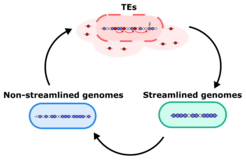Transposable Elements: What role do they play in genome evolution?
„Transposable elements (TEs)" are small DNA segments found in nearly all genomes across the tree of life. Their function is not fully understood, but their properties are remarkable: they can integrate themselves into DNA and also replicate there on their own, independent of their host. Therefore, it is assumed that the proliferation of TEs has contributed decisively to the genome size of eukaryotes. However, TEs are also found in prokaryotes, which have much smaller genomes. Moreover, their genomes are significantly streamlined, meaning a much smaller proportion is non-coding. What's behind this?
With the help of computer modeling, a team of researchers at the Max Planck Institute for Evolutionary Biology has now succeeded in shedding some light on the matter.
The scientists found that populations of streamlined genomes are better protected against TEs. Although individual cells "infected" with TEs are likely to die due to DNA damage, this early death prevents TEs from spreading in the population. This protective mechanism only works for asexual prokaryotes, and not for eukaryotes who reproduce sexually.
In the simulation, a three-way "rock-paper-scissors" equilibrium was established between streamlined populations, non-streamlined populations, and the TEs: First, the streamlined population prevails over the TEs, but the TEs do not die out. This is because with fewer TEs, selection in favor of the streamlined populations decreases. The non-streamlined populations have an advantage over the former because they are more robust to mutations. As the population of non-streamlined genomes increases, TEs once again have an opportunity to thrive, etc. (see figure).

The modeling shows that the "transposable elements" appear to be an important factor in the evolution of the size of a genome; they can cause both streamlining and enlargement.
